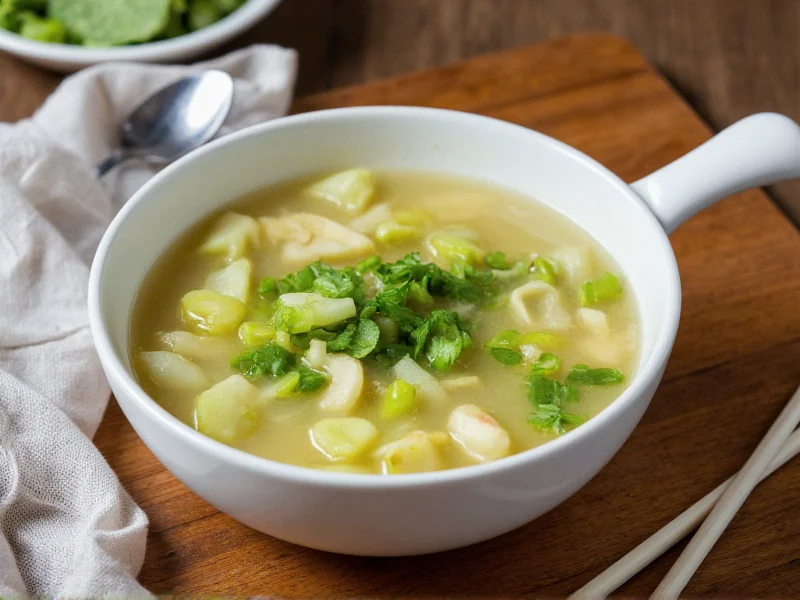Bitter melon soup represents one of Asia's most distinctive culinary traditions, combining unique flavor with nutritional value. This vibrant green vegetable, known scientifically as Momordica charantia, transforms dramatically when simmered in broth, creating a complex flavor profile that balances bitterness with savory depth. Understanding how to properly prepare this ingredient separates authentic bitter melon soup from disappointing attempts.
The Essence of Bitter Melon
Bitter melon, sometimes called bitter gourd or ku gua in Chinese, grows on vine plants throughout tropical and subtropical regions. The fruit develops distinctive ridges and a warty exterior that turns from green to yellow-orange as it ripens. Two primary varieties exist: the Chinese type with smoother skin and oblong shape, and the Indian variety featuring pointed ends and more pronounced ridges.
Nutritionally, bitter melon stands out with impressive vitamin C content (nearly twice that of oranges by weight), plus significant amounts of vitamin A, potassium, and dietary fiber. The compound momordicin creates the characteristic bitterness while contributing to the vegetable's potential metabolic benefits. When preparing bitter melon soup, understanding these properties helps balance flavor while preserving nutritional value.
Cultural Significance Across Asia
Traditional Chinese medicine has utilized bitter melon for centuries, considering it a cooling food that helps balance internal heat. In southern China, particularly Guangdong province, bitter melon soup appears regularly during summer months as a refreshing dish believed to combat humidity effects. The classic preparation combines sliced bitter melon with pork ribs, goji berries, and dried scallops in a clear broth.
Vietnamese cuisine features canh kho qua, where bitter melon halves stuffed with ground pork simmer in fish sauce broth. Indian preparations often include bitter melon in lentil-based soups or stir-fries with spices like turmeric and cumin to counteract bitterness. Each culture developed unique techniques to make this challenging ingredient palatable while harnessing its potential health properties.
Understanding Bitterness Management
Successful bitter melon soup preparation requires strategic bitterness management. Three proven techniques yield noticeably milder results:
| Technique | Process | Effectiveness |
|---|---|---|
| Salt treatment | Slice melon, toss with salt, wait 20 minutes, rinse | ★★★★☆ (Removes 60-70% bitterness) |
| Blanching | Boil slices 2-3 minutes, drain, rinse with cold water | ★★★☆☆ (Removes 40-50% bitterness) |
| Pairing ingredients | Add sweet elements like corn, carrots, or goji berries | ★★★☆☆ (Balances perception of bitterness) |
Combining salt treatment with strategic ingredient pairing produces the most balanced bitter melon soup. Younger melons with brighter green color naturally contain less bitterness than mature specimens. Removing the white pith during preparation significantly reduces bitter compounds since this tissue contains the highest concentration of momordicin.
Nutritional Profile and Considerations
Bitter melon soup delivers substantial nutritional value when prepared properly. A standard serving (1 cup) typically contains:
- Approximately 35 calories
- 2g dietary fiber (8% of daily value)
- 96mg vitamin C (107% of daily value)
- Significant potassium and vitamin A
- Trace amounts of iron and calcium
Research suggests bitter melon contains compounds that may support healthy blood sugar metabolism, though these findings shouldn't be interpreted as medical advice. The vegetable's high antioxidant content contributes to its potential health benefits. When preparing bitter melon soup for regular consumption, maintaining proper portion sizes ensures balanced nutrition without overwhelming bitterness.
Classic Bitter Melon Soup Recipe
This authentic preparation balances traditional techniques with accessible ingredients for home cooks seeking genuine bitter melon soup experience.
Ingredients
- 1 medium bitter melon (about 12 oz)
- 12 oz pork ribs or chicken bones
- 4 dried goji berries
- 2 dried scallops (optional but recommended)
- 1 small carrot, sliced
- 4 cups water
- 1 tsp salt (for treatment)
- Pinch of white pepper
Preparation Steps
- Cut bitter melon lengthwise, scrape out seeds and white pith
- Slice into 1/4-inch half-moons, toss with 1 tsp salt, wait 20 minutes
- Rinse thoroughly and squeeze out excess liquid
- Blanch pork ribs in boiling water for 2 minutes, discard water
- Combine ribs, 4 cups fresh water, dried scallops in pot, simmer 45 minutes
- Add bitter melon, carrot, goji berries, simmer 20 minutes
- Season with white pepper, adjust salt to taste
The soup develops optimal flavor when allowed to rest 10 minutes before serving. Properly prepared bitter melon should retain some bitterness but feature balanced savory notes from the meat and subtle sweetness from supporting ingredients. For vegetarian versions, replace meat with shiitake mushrooms and kombu for umami depth.
Regional Variations Worth Exploring
Different Asian cultures developed distinctive bitter melon soup preparations:
- Vietnamese stuffed bitter melon soup features hollowed melon halves filled with seasoned ground pork simmered in fish sauce broth
- Indian bitter melon dal combines sliced melon with lentils, turmeric, and mustard seeds for a protein-rich variation
- Thai bitter melon soup incorporates lemongrass, galangal, and kaffir lime leaves for aromatic complexity
- Okinawan goya champuru soup blends bitter melon with tofu and pork in a light soy-based broth
Modern adaptations include adding corn kernels to counteract bitterness or incorporating tomatoes for acidity balance. When experimenting with bitter melon soup variations, maintain the core preparation techniques while adjusting supporting ingredients to suit personal taste preferences.
Storage and Reheating Guidelines
Bitter melon soup maintains quality for 3-4 days when stored properly in airtight containers in the refrigerator. The bitterness often mellows slightly upon standing, creating a more balanced flavor profile the following day. For longer storage, freeze portions in freezer-safe containers for up to 3 months.
Reheat gently over medium-low heat to preserve texture and flavor balance. Avoid boiling vigorously as this can intensify bitterness. If reheating frozen soup, thaw overnight in the refrigerator before gentle reheating. The soup's nutritional value remains stable through proper storage, though vitamin C content gradually decreases over time.











 浙公网安备
33010002000092号
浙公网安备
33010002000092号 浙B2-20120091-4
浙B2-20120091-4